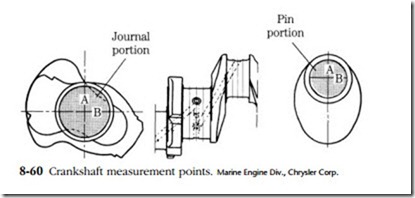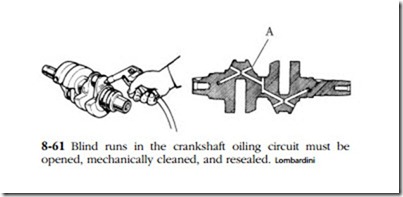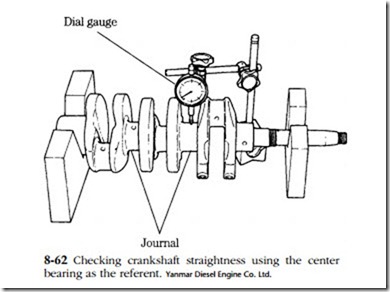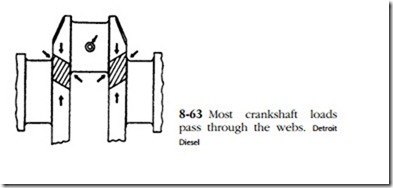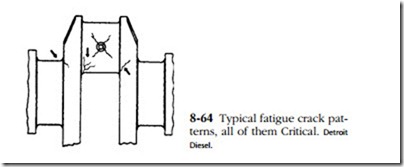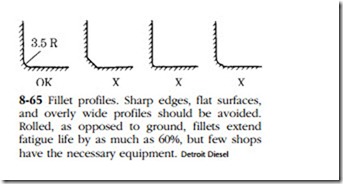Crankshafts
At this point we have progressed to the heart of the engine, the place where its durability will be finally established.
Construction
Crankshafts for the class of engine under discussion are, for the most part, steel forgings. Materials range from ordinary carbon steels to expensive alloys such as chrome-moly SAE 4140. A number of automotive engines and lightly stressed stationary power plants get by with cast-iron shafts, usually recognized by sharp, well-defined parting lines on the webs and by cored crankpins. Forging blurs the parting lines and mandates solid crankpins, which, however, are drilled for lubrication.
Most crank journals are induction-hardened, a process that leaves a soft, fatigue- resistant core under a hardened “skin.” Hardness averages about 55 on the Rockwell scale and extends to a depth of between 0.020–0.060 in. in order to accommodate regrinding. But a cautious machinist will test crankshaft hardness after removing any amount of metal.
A few extreme-duty crankshafts are hardened by a proprietary process known as Tufftriding. Wearing quality is comparable to that provided by chrome plating, but unlike chromium, the process does not adversely affect the fatigue life of the shaft.
Service
Remove the crankshaft from the block—a hoist will be required for the heavier shafts—and make this series of preliminary inspections:
• If a main bearing cap or rod has turned blue, discard the shaft, together with the associated cap or rod. The metallurgical changes that have occurred are irreversible. By the same token, be very leery of a crankshaft that is known to have suffered a harmonic balancer failure.
• Check the fit of a new key in the accessory-drive keyway. There should be no perceptible wobble. A competent machinist can rework worn keyways and, if necessary, save the shaft by fabricating an oversized key.
• Check the timing-gear teeth for wear and chipping. Magnetic-particle testing can be of some value when applied to the hub area, but cannot detect the subsurface cracks that signal incipient gear-tooth failure. Timing gear sprockets and related hardware should be replaced as a routine precaution during major repairs.
• Mike the journals and pins as shown in Fig. 8-60. Compare taper, out-of- roundness, and diameter against factory wear limits.
• If corrective machining does not appear necessary, remove with crocus cloth all light scratches and the superficial ridging left by bearing oil grooves. Tear off a strip of crocus cloth long enough to encircle the journal. Wrap the cloth with a leather thong, crossing the ends, to apply force evenly over the whole diameter of the journal. Work the crocus cloth vigor- ously, stopping at intervals to check progress. An Armstrong grinder works surprisingly fast.
• Using an EZ-Out or hex wrench, remove the plugs capping the oil pas- sages. Back-drilled sections of these passages serve as chip catchers, and must be thoroughly cleaned. Compressed air, shown in Fig. 8-61, helps but is no substitute for rifle-bore brushes, solvent, and elbow grease. Clean the plugs, seal with Loctite, and assemble.
• Check trueness with one or, preferably, tandem dial indicators while rotating the crank in precision V-blocks (Fig. 8-62).
Flaw testing
Flaw testing is generally done with the Magnaflux process, although some shops prefer to use the fluorescent-particle method. Both function on the principle that cracks in the surface of the crankshaft take on magnetic polarity when the crank is put in a magnetic field. Iron particles adhere to the edges of these cracks, making them visible. The fluorescent particle method is particularly sensitive because the metal particles fluoresce and glow under black light.
Most cracks are of little concern because the shaft is loaded only at the points indicated in Fig. 8-63. The strength of the shaft is impaired by crack formations which follow these stresses, as shown in Fig. 8-64. These cracks radiate out at 45° to the crank centerline and will eventually result in a complete break.
Abnormal bending forces are generated by main-bearing bore misalignment, improperly fitted bearings, loose main-bearing caps, unbalanced pulleys, or over- tightened belts. Cracks caused by bending start at the crankpin fillet and progress diagonally across.
The distribution of cracks caused by torsional (or twisting) forces is the same as for bending forces. All crankshafts have a natural period of torsional vibration, which is influenced by the length/diameter ratio of the crank, the overlap between crankpins and main journals, and the kind of material used. Engineers are careful to design the crankshaft so that its natural periodicity occurs at a much higher speed than the engine is capable of turning. However, a loose flywheel or vibration damper can cause the crank to wind and unwind like a giant spring. Unusual loads, especially when felt in conjunction with a maladjusted governor, can also cause torsional damage.
Crankshaft grinding
Bearings are available in small oversizes (0.001 and 0.002 in.) to compensate for wear. The first regrind is 0.010 in. Some crankshafts will tolerate as much as 0.040 in., although the heat treatment is endangered at this depth. The crankpin and main- journal fillets deserve special attention. Flat fillets invite trouble, because they act as stress risers. Gently radius the fillets as shown in the left drawing in Fig. 8-65.
All journals and pins should be ground, even if only one has failed. Use plenty of lubricant to reduce the possibility of burning the journal. Radius the oil holes with a stone and check the crankshaft again for flaws with one of the magnetic particle methods.
Surface hardness should be checked after machining and before the crank receives final polishing. Perhaps the quickest and surest way to do this is to use Tarasov etch. Clean the shaft with scouring powder or a good commercial solvent. Wash thoroughly and rinse with alcohol. Apply etching solution No. 1 (a solution of 4 parts nitric acid in 96 parts water). It is important to pour the acid into the water, not vice versa.
Rinse with clean water and dry. If you use compressed air, see that the system filter traps are clean. Apply solution No. 2, which consists of 2 parts hydrochloric acid in 98 parts acetone. Acetone is highly flammable and has a sharp odor that can produce dizziness or other unpleasant reactions when used in unventilated areas, so allow yourself plenty of breathing room.
The shaft will go through a color change if it has been burned. Areas that have been hardened by excessive heat will appear white; annealed areas turn black or dark gray. Unaffected areas are neutral gray. If any color other than gray is present, the shaft should be scrapped and the machinist should try again, this time with a softer wheel, a slower feed rate, or a higher work spindle speed. Some experimentation might be necessary to find a combination that works.
Cranks that have been Tufftrided must be treated after grinding to restore full hardness. One test is chemical: a 10% solution of copper ammonium chloride and water applied to the crankshaft reacts almost immediately by turning brown if a traditional heat treatment has been applied. There will be no reaction in 10 seconds if the crankshaft is Tufftrided. Another test is mechanical: Tufftriding is applied to the whole crankshaft, not just to the bearing journals. If a file skates ineffectually over the webs without cutting, one can assume that the shaft is Tufftrided.
Any heavy-duty crankshaft, forged or cast, can benefit from Tufftriding, if the appropriate bearing material is specified. This treatment is especially beneficial when the manufacturer has neglected to treat journal fillets. The abrupt change in hard- ness acts as a stress riser. Treatment should be preceded by heating the crankshaft for several hours at a temperature above 1060°F. It might be necessary to re-straighten the crankshaft.
